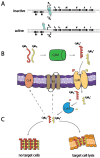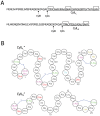Structure, function, and biology of the Enterococcus faecalis cytolysin
- PMID: 23628786
- PMCID: PMC3709268
- DOI: 10.3390/toxins5050895
Structure, function, and biology of the Enterococcus faecalis cytolysin
Abstract
Enterococcus faecalis is a Gram-positive commensal member of the gut microbiota of a wide range of organisms. With the advent of antibiotic therapy, it has emerged as a multidrug resistant, hospital-acquired pathogen. Highly virulent strains of E. faecalis express a pore-forming exotoxin, called cytolysin, which lyses both bacterial and eukaryotic cells in response to quorum signals. Originally described in the 1930s, the cytolysin is a member of a large class of lanthionine-containing bacteriocins produced by Gram-positive bacteria. While the cytolysin shares some core features with other lantibiotics, it possesses unique characteristics as well. The current understanding of cytolysin biosynthesis, structure/function relationships, and contribution to the biology of E. faecalis are reviewed, and opportunities for using emerging technologies to advance this understanding are discussed.
Figures


Similar articles
-
The Enterococcus faecalis cytolysin: a novel toxin active against eukaryotic and prokaryotic cells.Cell Microbiol. 2003 Oct;5(10):661-9. doi: 10.1046/j.1462-5822.2003.00310.x. Cell Microbiol. 2003. PMID: 12969372 Review.
-
Molecular Mechanism of Quorum-Sensing in Enterococcus faecalis: Its Role in Virulence and Therapeutic Approaches.Int J Mol Sci. 2017 May 3;18(5):960. doi: 10.3390/ijms18050960. Int J Mol Sci. 2017. PMID: 28467378 Free PMC article. Review.
-
Enterococcal cytolysin: activities and association with other virulence traits in a pathogenicity island.Int J Med Microbiol. 2004 Apr;293(7-8):609-18. doi: 10.1078/1438-4221-00301. Int J Med Microbiol. 2004. PMID: 15149038 Review.
-
Structural analysis and proteolytic activation of Enterococcus faecalis cytolysin, a novel lantibiotic.Mol Microbiol. 1996 Sep;21(6):1175-84. doi: 10.1046/j.1365-2958.1996.831449.x. Mol Microbiol. 1996. PMID: 8898386
-
Isolation of VanB-type Enterococcus faecalis strains from nosocomial infections: first report of the isolation and identification of the pheromone-responsive plasmids pMG2200, Encoding VanB-type vancomycin resistance and a Bac41-type bacteriocin, and pMG2201, encoding erythromycin resistance and cytolysin (Hly/Bac).Antimicrob Agents Chemother. 2009 Feb;53(2):735-47. doi: 10.1128/AAC.00754-08. Epub 2008 Nov 24. Antimicrob Agents Chemother. 2009. PMID: 19029325 Free PMC article.
Cited by
-
Genomic and phenotypic diversity of Enterococcus faecalis isolated from endophthalmitis.PLoS One. 2021 Apr 14;16(4):e0250084. doi: 10.1371/journal.pone.0250084. eCollection 2021. PLoS One. 2021. PMID: 33852628 Free PMC article.
-
Evaluation of Safety and Probiotic Potential of Enterococcus faecalis MG5206 and Enterococcus faecium MG5232 Isolated from Kimchi, a Korean Fermented Cabbage.Microorganisms. 2022 Oct 20;10(10):2070. doi: 10.3390/microorganisms10102070. Microorganisms. 2022. PMID: 36296346 Free PMC article.
-
The manifold roles of microbial ribosomal peptide-based natural products in physiology and ecology.J Biol Chem. 2020 Jan 3;295(1):34-54. doi: 10.1074/jbc.REV119.006545. Epub 2019 Nov 29. J Biol Chem. 2020. PMID: 31784450 Free PMC article. Review.
-
Enterococcus infection biology: lessons from invertebrate host models.J Microbiol. 2014 Mar;52(3):200-10. doi: 10.1007/s12275-014-4011-6. Epub 2014 Mar 1. J Microbiol. 2014. PMID: 24585051 Free PMC article. Review.
-
Aloe-Emodin-Mediated Photodynamic Therapy Attenuates Sepsis-Associated Toxins in Selected Gram-Positive Bacteria In Vitro.J Microbiol Biotechnol. 2021 Sep 28;31(9):1200-1209. doi: 10.4014/jmb.2105.05024. J Microbiol Biotechnol. 2021. PMID: 34319262 Free PMC article.
References
Publication types
MeSH terms
Substances
Grants and funding
LinkOut - more resources
Full Text Sources
Other Literature Sources
Molecular Biology Databases

